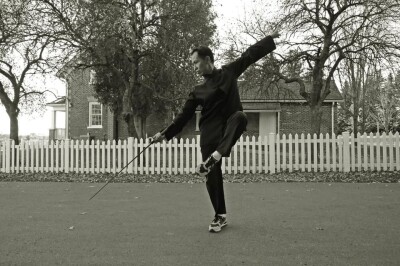Fist of Hitting and Lifting
The flip from one side to another needs to happen because of torso going down. More precisely, the two shoulder-to-kua axes go up and down against the central non-moving axis. Read more
Chen Zhonghua Taiji Academy Phone: 780-413-0454
Chen Taiji Practical Method and Hunyuan Taiji practical_method@outlook.com
by Kelvin Ho on 2021/04/23
Fist of Hitting and Lifting
The flip from one side to another needs to happen because of torso going down. More precisely, the two shoulder-to-kua axes go up and down against the central non-moving axis. Read more
by Kelvin Ho on 2021/04/21
Fist of Lifting and Blocking 搬拦肘
by Kelvin Ho on 2021/04/16
Common mistake in push hands:
by Kelvin Ho on 2021/04/15
by Kelvin Ho on 2021/04/02
by Kelvin Ho on 2021/04/02
by Kelvin Ho on 2021/04/02
Go over the threshold 过关: hand and shoulder
Get to the special spot 窍: tip of the elbow, inner spot of kua to come out, back of the knee to find alignment, spot at the bottom of the neck
Master Chen explained the switching of the kuas again, how they are like two credit cards touching each other in a T configuration. We need to create a gap and then do the switch.
Read more
by Kelvin Ho on 2021/03/30
Exercise 1: Use the kua to push the hand out. Shoulder, kua and elbow are one piece. The hand stretches against the shoulder. This is a very practical push hand move.
Exercise 2: Elbow Strike (the elbow has to come out)
Exercise 3: Double Push Hands: Pull the opponent in, Front foot goes forward, rear foot follows. Two hands go out from the dantian with a trajectory. We use the back foot to push.
by Kelvin Ho on 2021/03/29
We started with forearm lever exercise. Aim at a dot to create a pivot. The distance the elbows goes down is the same as the distance the finger tip goes up (assuming the pivot is right in the middle).
Ratio 1:1
The meaning is that nothing is left in the middle. Every in-coming thing must go out. This is also called neutralization.
When we eat rice, ideally, we just want the energy, and other physical things should come out of the body. However, there is always some small amount of material, e.g. mineral that remains in the body. This is what causes us to be sick and become old.
Resolving door: One side comes in, the other side goes out. The key is that the door is very solid.
In our movement, redirect the incoming force to the rear foot without moving.
To be soft, it must be solid plus rotation.
by Kelvin Ho on 2021/03/26
Train with the rear foot at the corner, and a big enough stance to lock the body (especially upper body).
Taiji is only realized with speed.
Read more
by Kelvin Ho on 2021/03/25
Exercise 1: Use the left hand to grab the right wrist, stretch the right fingers. This is not just a demonstration, it is the method to train. People often ask Master Chen how to train, in fact, he just showed us. We only need to do it 60 times in each session. Doing it 60 times means to not use too much power, or using the right amount such that you can do it 60 times. When you use the left hand to grab the right, squeeze the armpit to lock the left hand, so that the left hand itself does not move. In order to stretch, we must lock something.
Read more
by Kelvin Ho on 2021/03/24
When the body action is correct, the energy is wrong.
When the energy is correct, the body action is wrong.
Read more
by Kelvin Ho on 2021/03/23
Maintain two lines (This exercise came from Twisting the towel.)
We want to first stretch things out, and then add something in the middle to further stretch a little bit. We must constantly add that little bit of stretch in our training. This is neigong training.
Read more
by Kelvin Ho on 2021/03/19
Fetch Water
Application: Shoulder strike (kao), power comes from dantian
Read more
by Kelvin Ho on 2021/03/18
On Mar 12, 2021, Master Chen was instructing on an exercise, in which, I put up my left forearm in front of and parallel to my chest. I need to push the elbow downwards with a pivot in the middle of my forearm, with the load on the hand. The desired outcome requires me to create an independent setup of a lever, and then press down on one side of the lever (elbow). This is separation of yin and yang because the downward force is independent of the lever setup. The lever setup cannot break or change its integrity when the downward force is applied. The outcome of the lever action is predetermined by the setup. The downward force when applied in a specific way simply makes it happen. If the downward force is not applied correctly or the lever setup breaks down, the desired outcome will not happen.
Read more
by Kelvin Ho on 2021/03/15
What is success? It’s to never give up.
Why would one give up? He had a change of heart.
中文两字词语是阴阳的。信念 – 信往外,念往内。
Read more
by Kelvin Ho on 2021/03/14
by Kelvin Ho on 2021/03/12
Think about the rods/bars that link the old kind of train’s wheels together. Those rods only ever go forward even those each wheel only rotates. This is yin-yang reversal. There is a joint in the middle of the wheel, there is another joint at the place where the rod is attached to the wheel. If there is no such joint and the rod is totally glued to the wheel, as the wheel rotates, the rod will also turn around with the wheel.
Read more
by Kelvin Ho on 2021/03/12
Put the elbow on the table.
Shoulders goes down to the elbow.
Read more
by Kelvin Ho on 2021/03/05
Hold a rod not by grabing it with the whole palm, but split the span into two dots. One dot on the index finger underneath the rod acts as the pivot, and another one at the root of the palm placed above the rod acts as the balancing arm. We can tilt the rod the other end of the rod this way without lifting the rod itself.
This is what allows the power to go along the rod to the other end, and it is said to go over.
Read more
by Kelvin Ho on 2021/02/26
During training (when we are not yet successful), we use extra effort and focus to get it. It is tiring.
Once you are successful, the body gets used to it and will not be tiring anymore. The hair has been combed. The effort has gone through a filter. Read more
by Kelvin Ho on 2021/02/26
This lesson is about staying on topic, and then categorization within a topic.
There are only 3 types of movements in Practical Method:
by Kelvin Ho on 2021/02/25
The axis in real usage exists only functionally. 滚珠轴承 Ball Bearing.
We create a shell (restriction) on the outside, then the axis inside must exist, but you can’t touch it unlike a real rod in a globe.
Read more
by Kelvin Ho on 2021/02/24
Key things, e.g.
We must remember the key things even if we don’t understand it. Read more
by Kelvin Ho on 2021/02/19
by Kelvin Ho on 2021/02/18
by Kelvin Ho on 2021/02/17
by Kelvin Ho on 2021/02/17
When we do the correct taiji actions, your opponent will always feel your actions are awkward to him. We just do what we train to do.
对手对不上。
by Kelvin Ho on 2021/02/17
Negative Circle
by Kelvin Ho on 2021/02/10
by Kelvin Ho on 2021/01/28
Two power training exercises on BWAPM
by Kelvin Ho on 2021/01/22
by Kelvin Ho on 2021/01/20

Master Chen Zhonghua only teaches a reference implementation, which represents an example of how the principle is applied. There are many parts that need to be examined, explored and learned. We must focus our effort on learning all the parts of the reference implementation, how they form part of a system, how each part functions, and the role each part plays, what the effect when all the parts work together, etc. We have to go over this reference implementation over and over again, because there is always something we miss previously.
Examples of fajin:
by Kelvin Ho on 2021/01/14
Master Chen demonstrated Lu, Cai, and Lie with in-with-elbow in “Shake the Pole”. These three belong to the same group.
Lu 捋 – You grab the opponent’s arm, pull him in, and throw him onto the other side. There is no severance of the arm in this case.
Cai 採 – You grab the opponent’s arm, and pull on it quickly to sever it at the shoulder. This is like plucking a flower.
Lie 挒- You grab the opponent’s arm, and pull him in. He hits your body, which provides a stop to the incoming force. This also allows the arm to be severed at the shoulder.
by Kelvin Ho on 2021/01/10

2020 was a very different year. The world suffered from covid-19, everyone had to experience a lot of changes. Master Chen Zhonghua used to hold workshops all over the world non-stop throughout the year, which was inevitably halted, but Practical Method seeked to adapt and developed an online teaching platform with the latest technology. From a set of random classes to regularly scheduled classes by the beginning of 2021, the participating students made rapid progress and benefited a lot from them. This was largely due to being able to have more timely access to Master Chen Zhonghua and his instructors for guidance. The pandemic created an opportunity to allow a new level of Practical Method to soar to a higher level in the new year. Read more
by Kelvin Ho on 2021/01/09
A practice from the east to the west and the north to the south across the globe.
Read more
To create a stick, we, we need to stretch.
To rotate, we also need to stretch.
In both cases, there are both restrictions and the attempts to break the restriction.
In the first case, A and C are restricted from moving, while B is forced to break the A and C apart along the A-C line.
In the second case, the rod is restricted from moving, while the rubber band is pulled and stretched away from the rod. If the rubber band is ever loose, the little nudge cannot cause the rotation.
